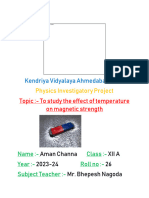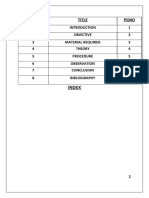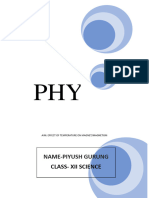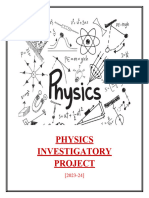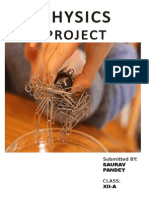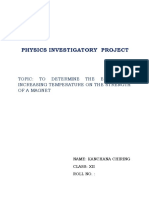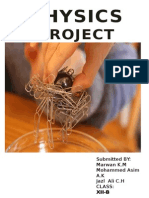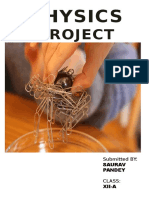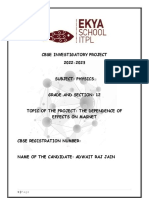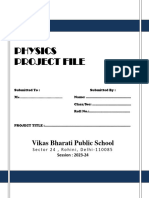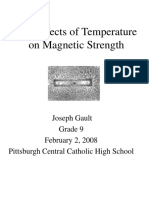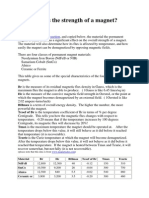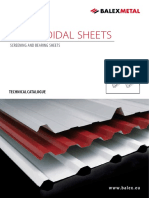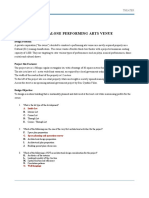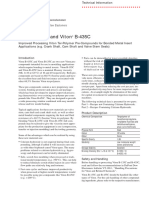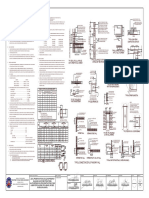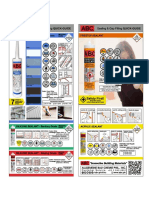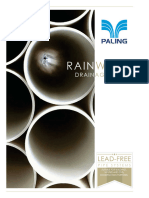Physics Investigatory project
To study the effect of
temperature on magnetic
strength
By
Name- Aniket khandelwal
Class-12 Section- E
Roll no. - <Board Roll no>
� CERTIFICATE ::
This is to certify that Aniket Khandelwal of class XII has
completed the chemistry project entitled ‘STUDY OF EFFECT
OF TEMPERATURE ON MAGNETIC STRENGTH’ herself and
under my guidance during the academic year 2022-23 The
progress of the project has been continuously reported and
has been in my knowledge consistently .
Maninder Bhatia Ma’am. Surabhi Raghuvanshi Ma’am
Principal Head of Physics Department
GVN:-The Global School GVN:-The Global School
Examiner
�INDEX
#Aim
#Introduction
#Objective
#Material Required
#Cold Process
#Hot Process
#Procedure
#Observation
#Conclusion
#Bibliography
� ACKNOWLEDGEMENT::
In the accomplishment of this project
successfully. I would like to thank my
principal Mrs Maninder Bhatia and
chemistry teacher Mrs Surabhi
Rghuwanshi whose valuable
guidance has helped me make this
project a foolproof success. Her
suggestions and her instructions
have served as a major contributors
towards the completion of this
project. Also, I would also like to
thank my parents and my friends
who had helped me throughout
� Aim::
To study
the e ect of
temperature
on magnetic strength
ff
� INTRODUCTION::
Magnets are frequently used in daily
life. For example, magnets are used in
manufacturing, entertainment,
security and they play a crucial role in
the functioning of computers. Even the
earth itself is a magnet. A magnet is
any object that produces a magnetic
field . Some magnets, referred to as
permanent, hold their magnetism
without an external electric current. A
magnet of this nature can be created
by exposing a piece of metal
containing iron to a number of
situations (i.e. repeatedly jarring the
metal, heating to high temperature).
Soft magnets, on the other hand, are
those that lose their magnetic charge
properties over time. Additionally,
paramagnetic objects are those that
�can become magnetic only when in
the presence of an external magnetic
field. A magnetic field is the space
surrounding a magnet in which
magnetic force is exerted. The motion
of negatively charged electrons in the
magnet determines not only the
polarity ,but also the strength of the
magnet (Cold magnet). Magnets are
filled with magnetic lines of force .
These lines originate at the north pole
of the magnet and continue to the
south pole. The north pole is positive.
Magnetic lines of force do not
intersect one another. Magnetism is
created by the alignment of small
domains within a specific set of metal.
These domains function as all atoms
do, thus the temperature affects the
movement. The higher the heat, the
�greater the energy, and as such the
movement of the particles. In contrast,
cold temperature slows the
movement (magnetic Field Strength
and Low Temperatures). Slower
movement leads to more fixed
directions in terms of the domains. In
the 1800’s, Pier4re Curie discovered
that there exists a temperature at
which objects that were previously
permanently magnetic loses this
characteristic .The temperature at
which this demagnetisation occurs is
called the “Curie point”. As the
temperature of the magnet
approaches this point, the alignment
of each domain decreases. As such,
the magnetism decreases until the
Curie point is reached, at which time
the material becomes paramagnetic.
� OBJECTIVE ::
TO DETERMINE THE EFFECT OF
TEMPERATURE ON MAGNETIC
STRENGTH
Hypothesis::
It is believed that the colder the
magnet, the stronger the magnetic
force. Graphically, the results will
resemble an exponential curve, with
magnetic force decreasing as
temperature increases. Our
independent variable is temperature.
Our dependent variable is magnetism;
this will be calculated using the
amount of paperclips that the magnet
is able to collect at each measured
temperature
� Materials required::
• Safety glasses
• 3-4 permanent bar magnets
• Tongs for magnet
• Ice
• Water
• Insulating container
• Three strong bowls
• Small pot
• Burner for heating water or oven
• Paper clips(1000)
� Theory::
A magnet is a material or object that
produces a magnetic field. This
magnetic field is invisible but is
responsible for the most notable
property of a magnet: a force that pulls
on other ferromagnetic materials, such
as iron, and attracts or repels other
magnets. A permanent magnet is an
object made from a material that is
magnetized and creates its own
persistent magnetic field. An everyday
example isa refrigerator magnet used
to hold notes on a refrigerator door.
Materials that can be magnetized,
which are also the ones that are
strongly attracted to a magnet, are
called ferromagnetic (or ferrimagnetic).
These include iron, nickel, cobalt ,some
alloys of rare earth metals, and some
naturally occurring minerals such as
�lodestone. Although ferromagnetic (and
ferrimagnetic) materials are the only
ones attracted to a magnet strongly
enough to be commonly considered
magnetic, all other substances respond
weakly to a magnetic field, by one of
several other types of magnetism.
Ferromagnetic materials can be divided
into magnetically "soft" materials like
annealed iron, which can be
magnetized but do not tend to stay
magnetized, and magnetically "hard"
materials, which do. Permanent
magnets are made from"hard"
ferromagnetic materials such as a link
and ferrite that are subjected to special
processing in a powerful magnetic field
during manufacture, to align their
internal microcrystalline structure,
making them very hard to
demagnetize. To demagnetize a
�saturated magnet, a certain magnetic
field must be applied, and this
threshold depends on coercivity of the
respective material. "Hard" materials
have high coercivity, whereas "soft"
materials have low coercivity. The
overall strength of a magnet is
measured by its magnetic moment or,
alternatively, the total magnetic flux it
produces. The local strength of
magnetism in a material is measured
by its magnetization.
� ColdProcess::
1. Place paperclips in bowl.
2. Situate scale near bowl.
3. Weigh magnet and record.
4. Place magnet and freezer
thermometer in freezer set to
lowest temperature possible.
5. Wait approximately 20 minutes for
the magnet to reach the
temperature of the freezer.
6. Record temperature read by
freezer thermometer.
7. Place magnet in bowl filled with
paperclips.
8. Remove magnet and attached
paperclips and place on scale.
9. Record temperature of magnet
and grams attracted.
�10. Subtract the weight of the magnet
from the weight of the magnet and
the paperclips combined.
11. Remove paperclips and place
back in bowl.
12. Set freezer to 5-Celsius degrees
higher than previous temperature.
(Note: freezer accuracy is dubious.
Use temperature read by freezer
thermometer)
13. Repeat steps 4-12 until freezer
and magnet have reached zero
degrees Celsius
� Hot Process::
1. Place paperclips in the bowl.
2. Situate scale near bowl.
3. Weigh magnet and record.
4. Place magnet in oven set to highest
temperature possible.
5. Wait approximately 20 minutes for the
magnet to reach the temperature of the oven.
6. Place magnet in bowl filled with paperclips.
7. Remove magnet and attached paperclip
stand place on scale.
8. Record temperature of magnet and grams
attracted.
9. Subtract the weight of the magnet from the
weight of the magnet and the paperclips
combined.
10. Remove paperclip-stand place back in
bowl.
11. Allow magnet to rest for 5 minutes
undisturbed.
12. Repeat steps6-11 until magnet reaches
room temperature
� Observations::
1. Magnet Under Extreme heat
Time after removed from Weight attached (in grams)
oven (minutes)
0 200
5 200
10 240
20 210
25 230
30 220
35 206
�2. Magnet under extreme cold
Temperate(in Celsius) Weight attached (in grams)
-21.3 275
-19.4 275
-18.1 265
-15.3 270
-13.7 260
-6.7 245
0 225
� CONCLUSIONS::
Magnetic materials should maintain a
balance between temperature and
magnetic domains (the atoms’
inclination to spin in a certain
direction). When exposed to extreme
temperatures, however, this balance
is destabilized; magnetic properties
are then affected. While cold
strengthens magnets, heat can result
in the loss of magnetic properties. In
other words, too much heat can
completely ruin a magnet. Excessive
heat causes atoms to move more
rapidly, disturbing the magnetic
domains. As the atoms are sped up,
the percentage of magnetic domains
spinning in the same direction
decreases. This lack of cohesion
weakens the magnetic force and
�eventually demagnetizes it entirely. In
contrast, when a magnet is exposed to
extreme cold, the atoms slow down so
the magnetic domains are aligned
and, in turn, strengthened.
Ferromagnetism The way in which
specific materials form permanent
magnets or interact strongly with
magnets. Most everyday magnets are
a product of ferromagnetism.
Paramagnetism A type of magnetism
that occurs only in the presence of an
external magnetic field. They are
attracted to magnetic fields, but they
are not magnetized when the external
field is removed. That's because the
atoms spin in random directions; the
spins aren’t aligned, and the total
magnetization is zero. Aluminum and
oxygen are two examples of materials
�that are paramagnetic at room
temperature. Curie Temperature
Named for the French physicist Pierre
Curie, the Curie Temperature is the
temperature at which no magnetic
domain can exist because the atoms
are too frantic to maintain aligned
spins. At this temperature, the
ferromagnetic material becomes
paramagnetic. Even if you cool the
magnet, once it has become
demagnetized, it will not become
magnetized again. Different magnetic
materials have different Curie
Temperatures, but the average is
about 600 to 800 degrees Celsius.
� Bibliography::
# www.google.com
# www.wikepedia.com
# www.icbse.com










